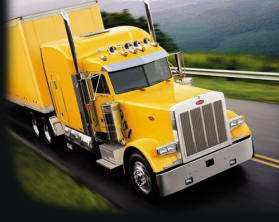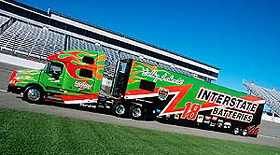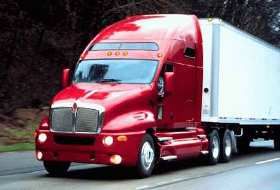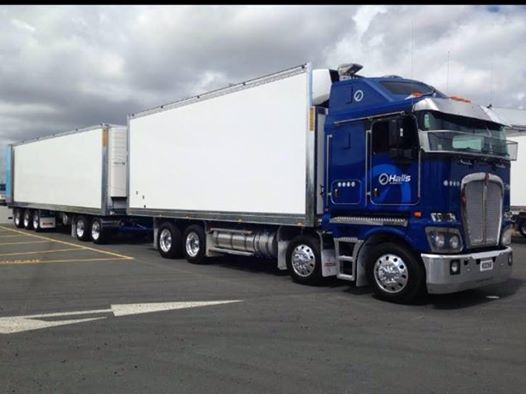Taking A Look At Securing A Flat-Bed Load
Topic 3287 | Page 1

Why the stake pocket and not one of the round things to either side? I've never done either, but securing these down looks like less work than a roll of steel.

Why the stake pocket and not one of the round things to either side? I've never done either, but securing these down looks like less work than a roll of steel.
If I had to take a guess at it I would say look at how wide the tear drop loop of the chain is speard which allows the hook to be more at a 90 degree angle from the chain so it can hook properly.
If one of the round ones was used it would not allow for the hook to catch the chain just right since it would be less of an angle.
That would be my best guess just looking at the pictures.

Old school, that was a very informative and well organized post. I can tell you put some time into it. Many thanks.
P.S. Maybe I'll read it later if I have time.

So you have a total of 14,800 pounds of chain and strap restraint on each of the big 17,400 pound transformers? 2 chains and a strap?
That would not be permitted here, as they are not loaded hard against a headboard they would have to be held down with TWICE the restraint of their mass. So those 17,400 Lb transformers would require 34,800 Lb of restraint.
http://www.nzta.govt.nz/resources/roadcode/heavy-vehicle-road-code/tlc-general-requirements/basic-criteria.html
TWIC:
Transportation Worker Identification Credential
Truck drivers who regularly pick up from or deliver to the shipping ports will often be required to carry a TWIC card.
Your TWIC is a tamper-resistant biometric card which acts as both your identification in secure areas, as well as an indicator of you having passed the necessary security clearance. TWIC cards are valid for five years. The issuance of TWIC cards is overseen by the Transportation Security Administration and the Department of Homeland Security.
HOS:
Hours Of Service
HOS refers to the logbook hours of service regulations.Oh man....you guys are killin me....now I really want to build a flatbed securement module into the High Road Training Program!
That was awesome, Old School!
That would not be permitted here, as they are not loaded hard against a headboard they would have to be held down with TWICE the restraint of their mass. So those 17,400 Lb transformers would require 34,800 Lb of restraint.
Note: for those who aren't familiar with Kiwi303 he's a truck driver in New Zealand!
That's really interesting Kiwi303! I'm curious what Old School will say about that....if there are any specifications here about loading against a headboard. I've only hauled heavy equipment around town on a flatbed and we just chained it down like crazy everywhere. So I'm not even familiar with the exact specs. But I've had loads shift forward in dry vans and refrigerated trailers, including one time when a load of those massive rolls of paper shifted forward under hard braking and actually pushed out on the sides of the trailer a little bit. That was uncomfortable, let me tell ya!
So I can see how slamming on the brakes without the load being up against the headboard could be disastrous!
CDL:
Commercial Driver's License (CDL)
A CDL is required to drive any of the following vehicles:
- Any combination of vehicles with a gross combined weight rating (GCWR) of 26,001 or more pounds, providing the gross vehicle weight rating (GVWR) of the vehicle being towed is in excess of 10,000 pounds.
- Any single vehicle with a GVWR of 26,001 or more pounds, or any such vehicle towing another not in excess of 10,000 pounds.
- Any vehicle, regardless of size, designed to transport 16 or more persons, including the driver.
- Any vehicle required by federal regulations to be placarded while transporting hazardous materials.
Dry Van:
A trailer or truck that that requires no special attention, such as refrigeration, that hauls regular palletted, boxed, or floor-loaded freight. The most common type of trailer in trucking.TWIC:
Transportation Worker Identification Credential
Truck drivers who regularly pick up from or deliver to the shipping ports will often be required to carry a TWIC card.
Your TWIC is a tamper-resistant biometric card which acts as both your identification in secure areas, as well as an indicator of you having passed the necessary security clearance. TWIC cards are valid for five years. The issuance of TWIC cards is overseen by the Transportation Security Administration and the Department of Homeland Security.
HOS:
Hours Of Service
HOS refers to the logbook hours of service regulations.Why the stake pocket and not one of the round things to either side? I've never done either, but securing these down looks like less work than a roll of steel.
Rico, the reason the "stake pocket" is used as opposed to one of the round things is because the stake pocket is a standard measurement of material and welding surface required by the D.O.T. regulations for flat-bed trailers, and it therefore has a specific WLL assigned to it. Those round things are merely spacers that hold the "rub rail" away from the edge of the trailer. They will vary from one trailer manufacturer to the next - sometimes they may be square things or half round things, I've even seen round rods used as spacers. I've also seen plenty of flat-bed loads where the driver used the spacers to secure his load, but technically it has no specific WLL and therefore should not be used for anchoring purposes.
HOS:
Hours Of Service
HOS refers to the logbook hours of service regulations.That would not be permitted here, as they are not loaded hard against a headboard they would have to be held down with TWICE the restraint of their mass. So those 17,400 Lb transformers would require 34,800 Lb of restraint.
Kiwi, I knew I would get some comments on this post concerning how this load was secured. There is nothing more entertaining than listening to a group of flat-bedders discuss how and why their load is secured the way it is, but I never dreamed the first person's comment would be from overseas!
Everything in our Federal Motor Carriers Guidelines are based on the WLL of the material being secured and that is always one half the weight of the material. We do have guidelines where header-boards are taken into consideration, and we have things to calculate such as forward acceleration and deceleration rates, rearward and lateral acceleration and deceleration rates, but I was trying to keep this discussion as simple and to the basics as I could so as not to be too confusing. It sounds to me like your load securement practices in New Zealand are more stringent than ours, and there is nothing wrong with that!
I once had a truck driver come up to me at a truck stop whose belly was the only thing more prominent than his ignorance, and started quizzing me as to why I had secured a load the way I did. But before I could even make a good start on answering him he interrupted me by sticking his thumbs up under his suspenders and saying "Waallll, the way I've always done it is this: I've got four kids at home that I wouldn't want to get hurt by a load coming off a truck, so I always put one strap on my loads for each kid, then I put one on their for Momma, and then just for good luck I will throw one more strap on there. That formula hasn't failed me yet!"
"Wow", I said, "I'm sure glad you put that last one on there for good luck, because that is the only reason you haven't killed someone else's kids yet."
I could have put two straps on each of these transformers in addition to the chains, but what I did meets the minimum requirements, and it made for a simpler explanation for the sake of those who are not so inclined to understand all the ins and outs of the technicalities of securing a load.
TWIC:
Transportation Worker Identification Credential
Truck drivers who regularly pick up from or deliver to the shipping ports will often be required to carry a TWIC card.
Your TWIC is a tamper-resistant biometric card which acts as both your identification in secure areas, as well as an indicator of you having passed the necessary security clearance. TWIC cards are valid for five years. The issuance of TWIC cards is overseen by the Transportation Security Administration and the Department of Homeland Security.
HOS:
Hours Of Service
HOS refers to the logbook hours of service regulations.Oh man....you guys are killin me....now I really want to build a flatbed securement module into the High Road Training Program!
Brett, I like the idea but we would really have to get it all down just right. Even now I come across different ways that D.O.T. officers will interpret some of the F.M.C.S.A. literature. I know you are not the type that backs down from a challenge, but that module is going to be a real challenge.
Brett, I like the idea but we would really have to get it all down just right. Even now I come across different ways that D.O.T. officers will interpret some of the F.M.C.S.A. literature. I know you are not the type that backs down from a challenge, but that module is going to be a real challenge.
And that's exactly why it will be so valuable to people. It's knowledge that people need to know, and anything that can be known can be taught.
I like the idea of starting with the FMCSA literature and enhancing that with real-world knowledge. That way people learn exactly what the Federal regulations are and they learn a whole lot about the practical application of it.
I've never even gone through the Federal regs on it. I'm gonna have to take a look at em....
CSA:
Compliance, Safety, Accountability (CSA)
The CSA is a Federal Motor Carrier Safety Administration (FMCSA) initiative to improve large truck and bus safety and ultimately reduce crashes, injuries, and fatalities that are related to commercial motor vehicle
FMCSA:
Federal Motor Carrier Safety Administration
The FMCSA was established within the Department of Transportation on January 1, 2000. Their primary mission is to prevent commercial motor vehicle-related fatalities and injuries.
What Does The FMCSA Do?
- Commercial Drivers' Licenses
- Data and Analysis
- Regulatory Compliance and Enforcement
- Research and Technology
- Safety Assistance
- Support and Information Sharing
Fm:
Dispatcher, Fleet Manager, Driver Manager
The primary person a driver communicates with at his/her company. A dispatcher can play many roles, depending on the company's structure. Dispatchers may assign freight, file requests for home time, relay messages between the driver and management, inform customer service of any delays, change appointment times, and report information to the load planners.New Reply:
New! Check out our help videos for a better understanding of our forum features

















Preview:
This topic has the following tags:
Driver Responsibilities Flatbed High Road Training Program Load Securement Photos Safe Driving Tips Understanding The Laws







 TT On Facebook
TT On Facebook
Editor's Note: We have an outstanding (and free!) online training program that teaches Flatbed Cargo Securement so check it out!
I thought some of you might enjoy looking at a brief explanation of how to secure a flat-bed load. This is just the very basic stuff that I used on a recent load of three electrical "step down" transformers. This load originated in Bland, VA. The two transformers on the back of the load were dropped in Philadelphia, PA, and the third unit was delivered to Branford, CT. There were phone numbers on the BOL's for the crane company that would unload them, and it was my responsibility to call and set up the appointment times to get them off-loaded.
Here's a photo of what this load looks like.
Before a flatbedder can figure out how to secure his load he must first know what it weighs. Unlike some "reefer" loads, the flat-bedder"s BOL's usually have fairly accurate weights listed on them - this is because their load securement practices are based on that information, or at least is is supposed to be. I did have a load recently though that had the numbers way off. I could tell immediately as I drove off with that load that it was way heavier than they said it was, so I drove right to the nearest CAT Scale and found I was going to be about twelve hundred pounds over gross weight if I filled up my fuel tanks. So I had to get that one delivered on fumes while dancing around the scales, but that's another story for another time.
Okay, once you know the weight of your load you've got to figure out what the WLL is. WLL is the "working load limit". If you can divide by two you just might qualify to be a flat-bedder, cause that's all a flat-bedder does to figure the WLL of his load. This load has three transformers on it and we need to know what each of them weighs because they each need to be secured as a separate unit. My BOL's tell me that the two units in the back weigh 17,400 lbs. each, and the smaller unit in the front weighs 5,500 lbs. After dividing these numbers by two we get a WLL of 8,700 lbs. for each of the larger units, and 2,750 lbs. for the smaller unit. These transformers are supposed to be secured to the trailer with chains through some steel rings welded near the base as per the manufacturers instructions. So now we need to know how much weight these chains can handle so we can make sure they are capable of keeping this load on the trailer until we can get it to it's destination. That means we need to know the WLL of the chains. This is called our equipment WLL.
I have on my truck ten sets of grade 70 5/16" chain. These chains are rated at 4,700 lbs. WLL. The 5/16" grade 70 snap binder we will tighten the chains with are rated at 5,400 lbs. WLL, and the stake pockets on the trailer which we will "tear drop" anchor our chains to are also rated at 5,400 lbs. WLL. These are D.O.T. required standards for these pieces of equipment. Okay the weakest piece of equipment in our example here is the chain itself at 4,700 lbs. WLL. So that will be the equipment WLL we will use for our calculation. The heaviest of our load WLL was the large transformers at 8.700 lbs. Two chains with a WLL of 4700 lbs. each should give us a WLL of 9,400 lbs., so two chains will secure each of the larger transformers and of course will be more than sufficient for the smaller unit.
Those of you who are observant are already wondering why the above photo shows a strap over the top of each transformer, and I am happy to satisfy your curiosity. There are two reasons why I added the strap across the top. First, I like for my equipment WLL to exceed my load WLL by 20% and we weren't quite there on the larger transformers if you examine the math. Secondly these transformers are tall and if some unexpected event such as an accident were to occur which might possibly cause a chain to fail these things could easily topple over onto that mini-van full of children we are always speculating about. That strap over the top is just a little extra insurance. By the way, a 4" synthetic strap is rated at a WLL of 5,400 lbs., so this load is now very secure and safe for travelling the 700 mile trip to CT.
Here's a close up photo of how the chain is "tear dropped" around the stake pocket on the trailer.
Here's a photo of the steel rings that the chain passed through on the transformers.
Always take your excess chain and wrap it around your binder and secure it in place with a bungee - some of those D.O.T. inspectors can get real nasty about loose chains laying on the bed of your trailer.
When ever you have a lengthy piece of strap out there in the breeze, if you will just put a half twist in it like this it won't be flapping around and causing you trouble later on down the road.
CDL:
Commercial Driver's License (CDL)
A CDL is required to drive any of the following vehicles:
CAT Scale:
A network of over 1,500 certified truck scales across the U.S. and Canada found primarily at truck stops. CAT scales are by far the most trustworthy scales out there.
In fact, CAT Scale offers an unconditional Guarantee:
“If you get an overweight fine from the state after our scale showed your legal, we will immediately check our scale. If our scale is wrong, we will reimburse you for the fine. If our scale is correct, a representative of CAT Scale Company will appear in court with the driver as a witness”
Reefer:
A refrigerated trailer.
HOS:
Hours Of Service
HOS refers to the logbook hours of service regulations.OOS:
When a violation by either a driver or company is confirmed, an out-of-service order removes either the driver or the vehicle from the roadway until the violation is corrected.